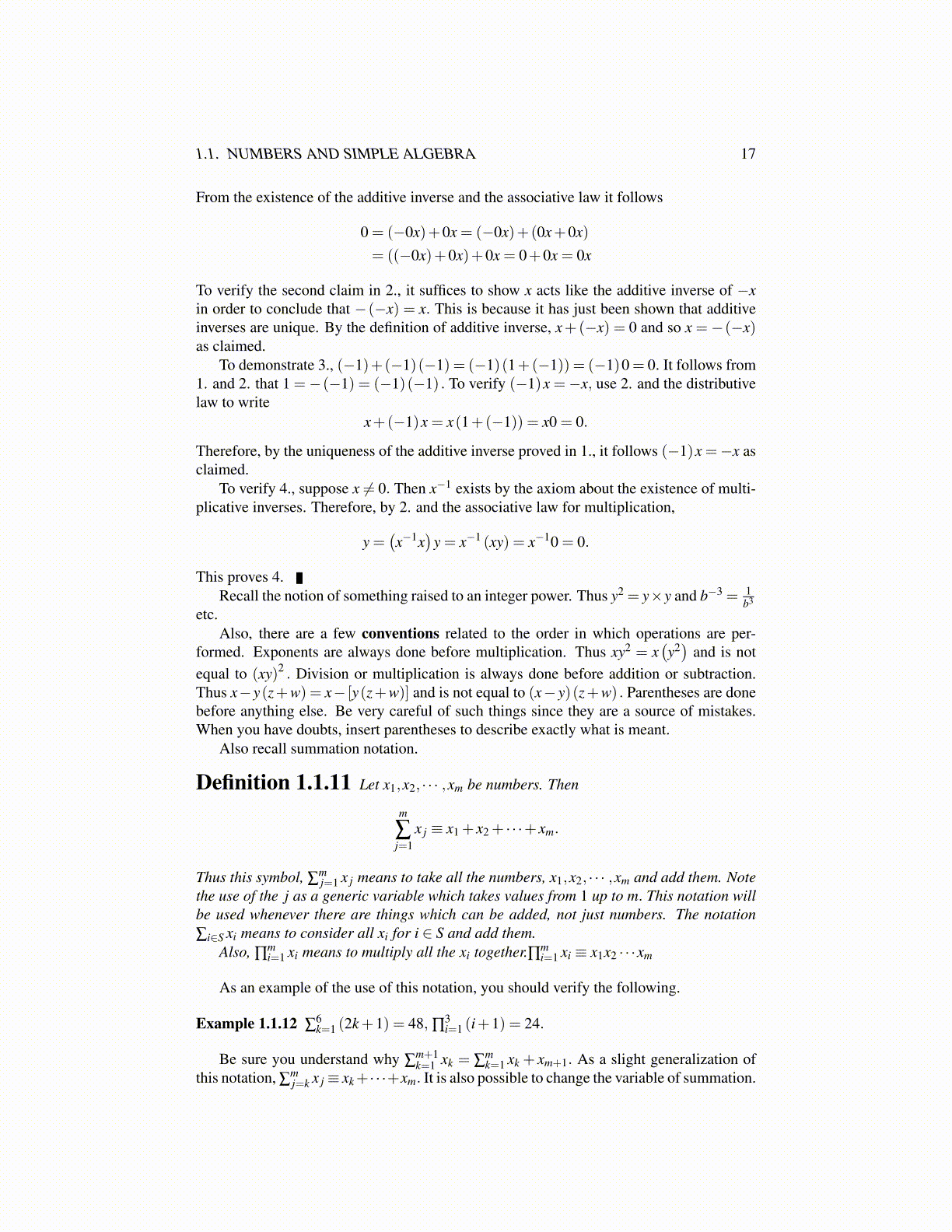
1.1. NUMBERS AND SIMPLE ALGEBRA 17
From the existence of the additive inverse and the associative law it follows
0 = (−0x)+0x = (−0x)+(0x+0x)
= ((−0x)+0x)+0x = 0+0x = 0x
To verify the second claim in 2., it suffices to show x acts like the additive inverse of −xin order to conclude that −(−x) = x. This is because it has just been shown that additiveinverses are unique. By the definition of additive inverse, x+(−x) = 0 and so x =−(−x)as claimed.
To demonstrate 3., (−1)+(−1)(−1) = (−1)(1+(−1)) = (−1)0 = 0. It follows from1. and 2. that 1 =−(−1) = (−1)(−1) . To verify (−1)x =−x, use 2. and the distributivelaw to write
x+(−1)x = x(1+(−1)) = x0 = 0.
Therefore, by the uniqueness of the additive inverse proved in 1., it follows (−1)x =−x asclaimed.
To verify 4., suppose x ̸= 0. Then x−1 exists by the axiom about the existence of multi-plicative inverses. Therefore, by 2. and the associative law for multiplication,
y =(x−1x
)y = x−1 (xy) = x−10 = 0.
This proves 4.Recall the notion of something raised to an integer power. Thus y2 = y×y and b−3 = 1
b3
etc.Also, there are a few conventions related to the order in which operations are per-
formed. Exponents are always done before multiplication. Thus xy2 = x(y2)
and is notequal to (xy)2 . Division or multiplication is always done before addition or subtraction.Thus x−y(z+w) = x− [y(z+w)] and is not equal to (x− y)(z+w) . Parentheses are donebefore anything else. Be very careful of such things since they are a source of mistakes.When you have doubts, insert parentheses to describe exactly what is meant.
Also recall summation notation.
Definition 1.1.11 Let x1,x2, · · · ,xm be numbers. Then
m
∑j=1
x j ≡ x1 + x2 + · · ·+ xm.
Thus this symbol, ∑mj=1 x j means to take all the numbers, x1,x2, · · · ,xm and add them. Note
the use of the j as a generic variable which takes values from 1 up to m. This notation willbe used whenever there are things which can be added, not just numbers. The notation∑i∈S xi means to consider all xi for i ∈ S and add them.
Also, ∏mi=1 xi means to multiply all the xi together.∏m
i=1 xi ≡ x1x2 · · ·xm
As an example of the use of this notation, you should verify the following.
Example 1.1.12 ∑6k=1 (2k+1) = 48, ∏
3i=1 (i+1) = 24.
Be sure you understand why ∑m+1k=1 xk = ∑
mk=1 xk + xm+1. As a slight generalization of
this notation, ∑mj=k x j ≡ xk+· · ·+xm. It is also possible to change the variable of summation.